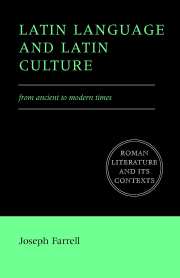4 - The life cycle of dead languages
Published online by Cambridge University Press: 26 January 2010
Summary
Structures of literary and cultural history
My previous chapter runs counter to the main argument of this book in one important respect. I want to maintain that Latin culture is best and most fully represented by the Latin language itself, and that it should be seen as a larger and more unified area than traditional disciplinary structures currently allow. But by accepting even provisionally the idea that classical Latin is gendered masculine, and medieval Latin feminine, or by locating medieval Latin in an intermediate zone of ambiguous gender between masculine, classical speech and the feminine vernacular, I am implicitly endorsing one of the longest-lived distinctions, and arguably the most pernicious, ever imposed upon latinity from ancient times down to the present.
Of course, Latin culture is vast and various. Even though we must try to comprehend it as a whole, it would be impossible to do so without some sense of interior articulation, whether by chronological periods, regional traditions, or other organizing principles. Problems occur when structures that arose to facilitate one kind of understanding end up blocking other channels of communication. This has unquestionably happened in the case of the most prevalent histories of Latin culture.
A recent book asks whether it is still possible to write literary history. Some might further question whether it is even desirable. But for students of a phenomenon as long-lived as Latin culture, historical thinking is indispensable, and the institutionalized maps and taxonomies of previous generations are almost impossible to do without.
- Type
- Chapter
- Information
- Latin Language and Latin CultureFrom Ancient to Modern Times, pp. 84 - 112Publisher: Cambridge University PressPrint publication year: 2001



